
95% of researchers rate our articles as excellent or good
Learn more about the work of our research integrity team to safeguard the quality of each article we publish.
Find out more
ORIGINAL RESEARCH article
Front. Sustain. Food Syst. , 28 March 2022
Sec. Climate-Smart Food Systems
Volume 6 - 2022 | https://doi.org/10.3389/fsufs.2022.861400
This article is part of the Research Topic Mixed Farming Technologies for Increased Resilience, Mitigation and Adaptation to a Changing Climate for Smallholder Farmers in Southern Africa View all 7 articles
Establishing the appropriate agronomic practices like fertilizer application is important for maximizing yield and improving nutritional quality of moringa (Moringa oleifera) leaves. The objective of the presented study was to determine the effects of nitrogen and phosphorus fertilizer rates on plant growth performance and leaf nutrient composition of moringa. The experiment was a 4 × 3 factorial, with four nitrogen levels (100, 200, 300, and 400 kg ha−1) and three levels of phosphorus (40, 80 and 120 kg ha−1). The experiment was laid out as randomized complete block design (RCBD), treatments were replicated four times. Twelve weeks after planting, the moringa trees treated with 100 kg N ha−1 and 80 kg P ha−1 were significantly taller by 46.8% than trees supplied with 400 kg N ha−1 and 120 kg P ha−1. Similarly, trees that received 100 kg N ha−1 and 80 kg P ha−1, and those treated with 200 kg N ha−1 and 80 kg P ha−1 had significantly greater stem diameter (>36%) compared to moringa trees that received 400 kg N ha−1 and 40 kg P ha−1. Crude protein was significantly higher by 26.3% in the 400 kg N ha−1 and 120 kg P ha−1 treatment combination than that of the 100 kg N ha−1 and 40 kg P ha−1 treatment combinations. Moringa trees that received 100 kg N ha−1 and 40 kg P ha−1 had the highest neutral detergent fiber content (30.71%), while the trees that received 400 kg N ha−1 and 120 kg P ha−1 had the lower neutral detergent fiber content of 22.77%. Based on the study, the combination of 100 kg N ha−1 and 80 kg P ha−1 can be recommended for maximum yield and nutritional content of moringa leaves.
Moringa is a multipurpose shrubby tree widely used for industrial purposes, home consumption, animal feed, and traditional medicine (Daba, 2016). Foidl et al. (2001) reported that every part of the tree is valuable: seeds can be used as a water purification agent; the bark, roots and flowers contain medicinal properties; and the leaves are a source of vital nutrients that can potentially supplement human food and animal feed. Moringa is a genus that belongs to the Moringaceae family (Olson, 2010). Moringa oleifera is the most commonly cultivated species (Sujatha and Patel, 2017) of the 13 moringa species. The tree started gaining popularity in South Africa around the year 2006 (Mashamaite et al., 2021). Production is however still at a developmental stage and is only confined to the backyards (Mabapa et al., 2017). Production and utilization of the tree by smallholder farmers in the Eastern Cape Province, South Africa is hampered by the lack of knowledge about its potential benefits (Moyo et al., 2011), growth habit, silvicultural management practices, seed availability, genetic improvement, and germplasm conservation (Gadzirayi et al., 2013). To promote moringa production in the Eastern Cape Province, it is essential to establish appropriate agronomic practices like fertilizer management that can maximize yield and improve the nutritional quality of moringa.
Smallholder farmers refer to farmers involved in mixed crop-livestock farming on small pieces of land, usually <2 ha (Nciizah et al., 2021; Nyambo et al., 2021), cultivating a mixture of food crops and sometimes cash crops (Nyambo et al., 2020a,b). Within these smallholder farms, the family members provide much of the labor and financial resources to generate food for the family and, at times, for extra income if there is a surplus produce (Louw, 2013; Nciizah et al., 2021). The Eastern Cape Province is dominated by rural areas where most farmers are resource-constrained and food insecure. The situation worsens because the province experiences significantly high rainfall variability and prolonged dry seasons, negatively impacting crop productivity (Ngaka, 2012). During drought seasons, grain crop production under dryland conditions becomes almost impossible, thus threatening food security (Nyambo et al., 2020c). Also, the smallholder farmers struggle to find enough and nutritious feed for their livestock. In such a situation, moringa can be used as a food supplement for humans and animals. Since moringa has a high commercial value, its cultivation can be a vital source of income that can enhance the smallholder farmers' livelihoods in the province (Mabapa et al., 2017). Therefore, there is a need to grow and utilize the moringa tree to enhance nutrition and food security, improve profitability, and reduce reliance on expensive imported feed supplements.
Nitrogen and phosphorus are essential elements required during the developmental stages of plants. Literature reports that nitrogen promotes vegetative growth while phosphorus improves root development in plants (Razaq et al., 2017). McDonald et al. (2011) reported that nitrogen increased crude protein and leaf biomass. Fodder crops are considered acceptable when crude protein is high, while neutral detergent fiber (NDF) and acid detergent fiber (ADF) contents are relatively low (Janhi et al., 2020). Crude protein above 8% with ADF and NDF ranging between 45 and 65% are highly recommended for good quality animal feed (Wangila et al., 2021). Fertilizer research on moringa are scarce for the conditions of the Eastern Cape Province, and reports in the literature are inconsistent. Some researchers reported that the plant performs very well without fertilizer application (Pahla et al., 2014; Mashamaite et al., 2021). However, fertilizer use, especially during the seedling establishment period, was reported to improve nutritional quality and biomass yield of moringa (Mabapa et al., 2017). Moringa seedlings grown in a glasshouse did not require a high amount of fertilizer, but a minimal intake could potentially improve its quality and yield (Christophe et al., 2019). Similarly, Pahla et al. (2014) reported that moringa seedlings planted in Zimbabwe without fertilizer application in soils with low nutrient status and poor drainage showed stunted growth and chlorosis of leaves, which resulted in a delayed growth rate and death of the plants. Francis and Liogier (1991) also reported that addition of fertilizer on moringa plants during the establishment phase resulted in increased foliage and seed yield. The contradictory results are possibly due to biomass and nutrient quality of moringa that are influenced by genetic background, climatic conditions, environment, and production practices (Brisibe et al., 2009). It is therefore it is essential to evaluate moringa production under the Eastern Cape Province conditions.
There are limited studies conducted to evaluate the effects of nitrogen and phosphorus rates on moringa yield and nutrient content in South Africa. This inadequacy of information makes it challenging to recommend to farmers on the fertilizer quantity and type to apply. Therefore, this study aimed to examine the effects of nitrogen and phosphorus application rates on moringa plants' growth and leaf nutrient composition. The study hypothesis is that nitrogen and phosphorus fertilizer application rates influence the growth and leaf nutrient composition of moringa.
The study was conducted at the University of Fort Hare Research Farm (32° 46' 282“ S and 26° 50' 067” E, at an altitude of 508 m above sea level). The experimental site receives an average annual rainfall of 535 mm, and has a mean annual temperature of 18.7°C (Nyambo et al., 2020c). The dominant natural vegetation is the Acacia species. Temperature and rainfall recorded during the study period are as given in Figure 1.
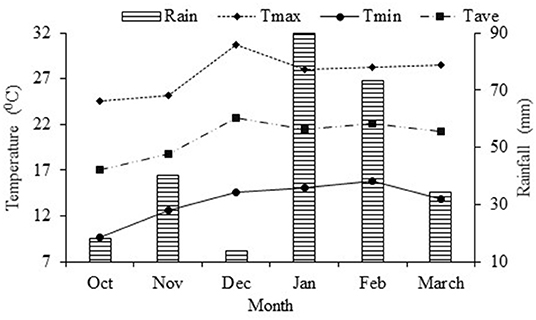
Figure 1. Average monthly rainfall, minimum (Tmin) and maximum (Tmax) temperature readings over the study period of October 2016 to March 2017.
A 4 × 3 factorial experiment (12 treatment combinations) was conducted. It was laid out in an RCBD, replicated four times. In each replication, each treatment was represented by 4 pots which had one plant per pot, to give a of total of 12 × 4 = 48 pots per replication, therefore the 48 × 4 replications giving a total of 192 pots or plants. The two factors were (a) nitrogen fertilizer at four levels viz 100, 200, 300 and 400 kg N ha−1 and (b) phosphorus fertilizer at three levels (40, 80, and 120 kg P ha−1). The nitrogen fertilizer levels were selected based on a study by Abdullahi et al. (2013), who recommended using the 200 kg N ha−1, and the phosphorus levels were based on the study by Mendieta-Araica et al. (2013), who recommended 44 kg P ha−1 as the optimum rates for improved biomass yield and nutrient quality Moringa. Half the nitrogen fertilizer was applied at planting, while the other half was applied 4 weeks after transplanting (WAP) in the form of lime ammonium nitrate (LAN, 28), Phosphorus treatments were incorporated into the soil before planting in the form of superphosphate (SSP, 10.5). Potassium fertilizer was applied basal at planting to all pots at a rate of 731 kg ha-1 using potassium chloride (KCl) Mendieta-Araica et al. (2013). Basal fertilizer application was done soon after transplanting.
The experiment was carried out using 10 L plastic pots filled with 8 kg of loam soil. Seedlings were raised onsite from seeds bought from Nala Farm, Johannesburg, South Africa. The seedlings were transplanted 4 weeks after planting (at a plant height of about 30 cm). Data collection was started 4 weeks after transplanting. The basic properties of the soil used in the study are shown as in Table 1.
Non-destructive parameters, such as plant height and stem diameter, were taken at 4, 8, and 12 weeks after transplanting. Plant height was measured using a 1 m ruler, while stem diameter was measured using a Vernier caliper.
All the leaves in the plants were harvested by hand, sorted and separated into 1.2 kg samples. All leaf samples were immersed into a large volume of potable water and shaken to remove impurities on the leaf surfaces. Thereafter, the leaves were taken out of water and allowed to dry on the surface of the perforated tables. All the samples were air-dried and dried until they were brittle, easy to crush and their moisture content dropping to below 8% (Fahey, 2005). After drying, the samples were milled with the leaf grinder into a fine powder using an (SMC hammer mill; Cape Town) that could pass through 1 mm sieve and stored in zipper polythene plastic pockets until analysis following a method previously described by Mbah et al. (2012). Chemical/nutritional analysis was done on air-dried leaves collected at 12 weeks after transplanting. Moisture, ash, and fat contents were determined using the standard procedures of the Association of Official Analytical Chemistry [Association of Official Analytical Chemistry (AOAC)., 1990]. Total nitrogen content was determined using the Kjeldahl method following Pearson (1976). Thereafter a factor of 6.25 was used to convert the nitrogen content into crude protein following Equation (1) (McDonald et al., 2011).
NDF and ADF were analyzed by the methods described by Goering and Van Soest (1970). Micro- and macro-elements were determined after digesting the leaf samples using aqua regia [3:1 v/v hydrochloric acid (37%): nitric acid (55%)] in a MARS 5 microwave digester (CEM Corporation, Matthews, North Carolina). Minerals were thereafter determined using the ICP-OES method (Varian Inc., The Netherlands).
Data collected were subjected to statistical analyses using JMP 15.0 statistical software (SAS Institute, Inc., Cary, NC, USA). Means were separated using Turkey's test at p < 0.05 when ANOVA indicated a significant P-value. Significant differences were identified at three probability levels; p < 0.05, 0.01, and 0.001. The study was done over 12 weeks; therefore, time was introduced as an extra factor when analyzing for growth. The statistical model for the parameters measured during the growing period is given in Equation (2);
Where: μ = the general mean
β = the blocking effect
Ai = the effect of nitrogen application rate
Bi = the effect of phosphorus application rate
Ai × Bi = the interaction effect of nitrogen and phosphorus application rate
εijk = the standard error.
The three-way interaction of nitrogen × phosphorus × time was highly significant (p < 0.0001) with respect to plant height, stem diameter and number of leaves (Table 2). Similarly, the two-way interactions of nitrogen × phosphorus; nitrogen × time and phosphorus × time had a significant effect (p < 0.0001) on plant height, stem diameter and the number of leaves. The main factors of nitrogen, phosphorus and time greatly influenced (p < 0.0001) plant height and stem diameter, while the effects of phosphorus and time was significant at p < 0.001 with respect to the number of leaves.
At four WAP, tallest moringa trees were recorded from the 100 kg N ha−1 and 80 kg P ha−1 treatment combination, while the 400 kg N ha−1 and 40 kg P ha−1 of the treatment combination produced the shortest trees. At 12 WAP, moringa trees supplied with 100 kg N ha−1 and 80 kg P ha−1, were 46.8% and 45% taller compared to trees that were supplied with a treatment of 400 kg N ha−1 and 120 kg P ha−1; and 300 kg N ha−1 and 120 kg P ha−1, respectively (Figure 2).
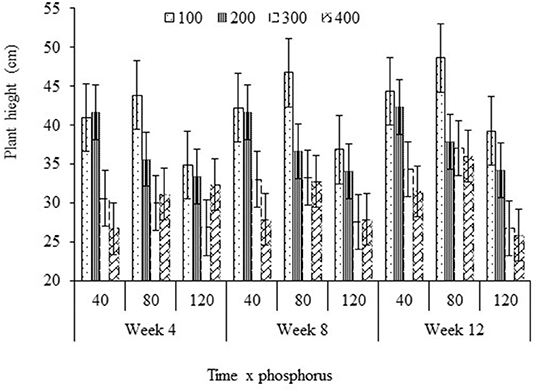
Figure 2. Effect of phosphorus and nitrogen rates on plant height. Error bars indicate standard error.
At eight WAP the results indicated that trees that received 100 kg N ha−1 and 80 kg P ha−1 had significantly thicker stems (11.12 mm) compared to trees that received the treatment of 400 kg N ha−1 and 80 kg P ha−1 (7.0 mm). Similarly, trees that received 100 kg N ha−1 and 80 kg P ha−1 and trees treated with 200 kg N ha−1 and 80 kg P ha−1 at twelve WAP had significantly greater stem diameter than trees that received treatment of 400 kg N ha−1 and 40 kg P ha−1 (Figure 3).
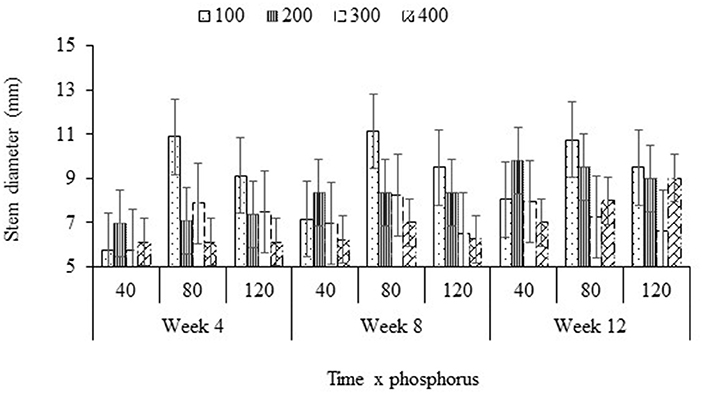
Figure 3. Effect of time phosphorus and nitrogen fertilizer on stem diameter. Error bars indicate standard error.
The 100 kg N ha−1 and 80 kg P ha−1 treatment combination had 16.9% more leaves than the plants that received 300 kg N ha−1 and 40 kg P ha−1 at 4 WAP. On the other hand, at four WAP, trees that received 400 kg N ha−1 and 120 kg P ha−1 had 40.1% more leaves than trees in the 300 kg N ha−1 and 120 kg P ha−1 treatment combination (Figure 4).
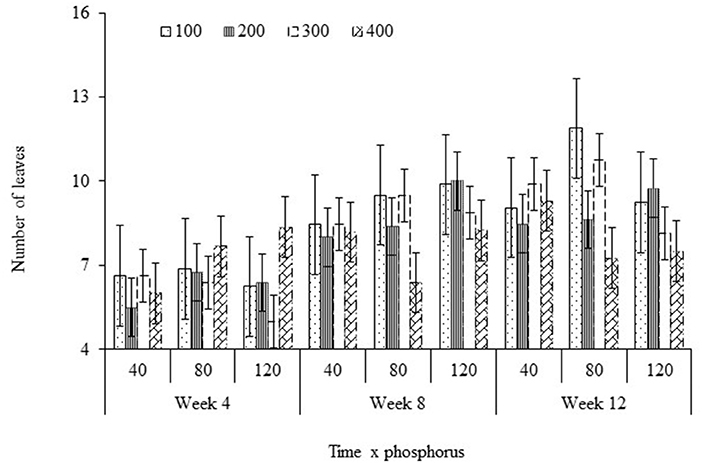
Figure 4. Effects of time, phosphorus and nitrogen fertilizer on the number of leaves of moringa trees. Error bars indicate standard error.
The interaction between the two factors nitrogen and phosphorus, was highly significant with respect to nutrients (p < 0.0001) and moisture (p < 0.001) (Table 3). The highest moisture content was recorded for the 300 kg N ha−1 and 40 kg P ha−1 treatment combination, while the least was in the treatment combination of 300 kg N ha−1 and 80 kg P ha−1 (Table 3). Ash contents was 21.38% higher in the treatment combination of 200 kg N ha−1 and 80 kg P ha−1, as compared to that of the 300 kg N ha−1 and 120 kg P ha−1 treatment combination. Crude protein significantly increased with levels of both nitrogen and phosphorus. The highest crude protein was obtained from the 400 kg N ha−1 and 120 kg P ha−1 treatment combination (38.28%), and the lowest in the 100 kg N ha−1 and 40 kg P ha−1 treatment combination (Table 3).
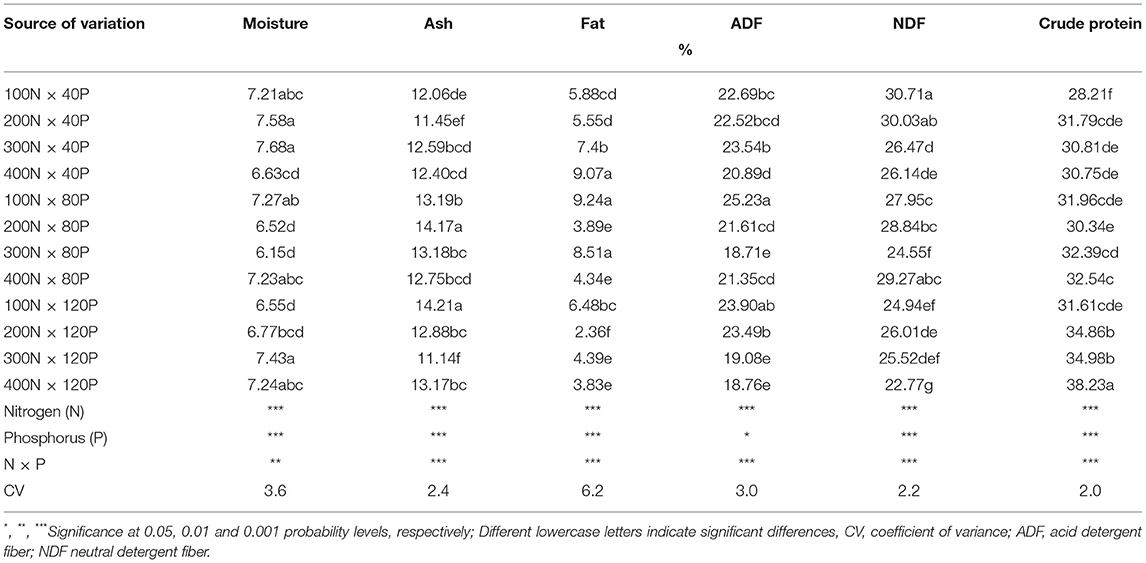
Table 3. Effect of nitrogen and phosphorus treatment combinations on moisture and chemical compositions of moringa leaves.
Interaction of nitrogen and phosphorus was highly significant (P < 0.0001) with respect to base cations and the K: (Ca+Mg) ratio (Table 4). Nitrogen depicted a high level of significance (p < 0.0001) with respect to Ca, Mg, and Na, while K was significant at p < 0.001. Effect of phosphorus was also highly significant (p < 0.0001) on Mg, Na and ratio of K: Ca+Mg, while the content of K was significant at p < 0.001. Only Ca was not significantly affected by P. Highest Ca content was observed in the treatment combination of 100 kg N ha−1 and 80 kg P ha−1, while the lowest was in the treatment combination of 300 kg N ha−1 and 40 kg P ha−1. Treatment combination of 100 kg N ha−1 and 120 kg P ha−1 had 94% Mg content higher than that of the treatment combination of 300 kg N ha−1 and 120 kg P ha−1 (Table 4). The K content was 15% higher in 100 kg N ha−1 and 120 kg P ha−1 compared to that of the 300 kg N ha−1 and 40 kg P ha−1 treatment combination (Table 4).
Highest concentrations of P and Zn were observed in the 400 kg N ha−1 and 120 kg P ha−1 treatment combination, while the lowest concentrations of P and Zn were from plants treated with 100 kg N ha−1 and 40 kg P ha−1 (Table 5).
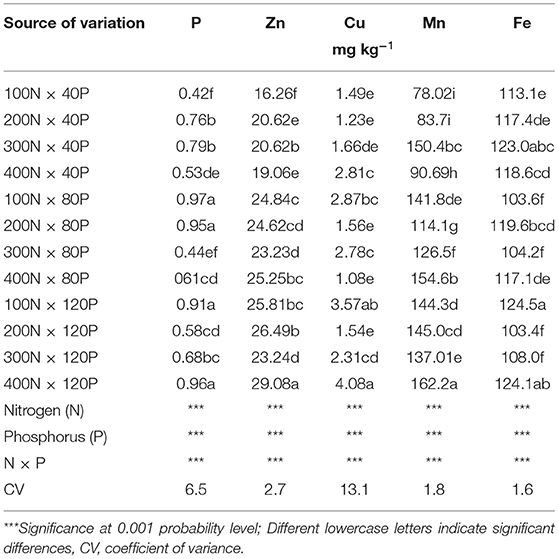
Table 5. Effect of nitrogen: phosphorus combinations on concentrations of phosphorus (P), Zinc (Zn), copper (Cu), manganese (Mn), and iron (Fe) in moringa leaves.
Copper was 73.5% higher in treatment combination of 400 kg N ha−1 and 120 kg P ha−1 compared to that of treatment combination of 400 kg N ha−1 and 80 kg P ha−1 (Table 5). The highest level of Fe content was record from 100 kg N ha−1 and 120 kg P ha−1 treatment combination and the lowest from 200 kg N ha−1 and 120 kg P ha−1 treatment combination (Table 5).
Various studies have attributed the increase in yield and quality of moringa plants to appropriate nutrient supply (Abdelwanise et al., 2015). In the current study, the 100 kg N ha−1 and 80 kg P ha−1 treatment consistently produced significantly taller plants at all three sampling times. Higher doses of both nitrogen and phosphorus fertilizers did not increase the height of the moringa tree. Similarly, stem diameter and number of leaves did not increase with an increase in the dosage of N and P fertilizers. Lack of a consistent growth increase with higher fertilizer doses indicates that the moringa plants did not require higher nitrogen and phosphorus. The lack of response to higher fertilizer doses could be because the experiment was conducted in the hot summer months of December and March 2016 (Figure 1). Nutrient utilization of plants, particularly nitrogen, can potentially be reduced when precipitation is low and temperatures are high (Kering et al., 2011). Similar results were reported by Palada (1996), who showed that higher nitrogen fertilizers rates did not significantly increase the plant height of moringa tree. However, contrasting results were also reported in other studies. In a study conducted in Zimbabwe on sandy soil, Pahla et al. (2014) reported that plant height and shoot and root dry matter contents significantly increased with an increase in fertilizer rates. The same authors reported that the best performance of the moringa trees was observed at a fertilizer combination of 276 kg N ha−1 and 400 kg ha−1 P2O5. In a study conducted by Abdullahi et al. (2013) in North central Nigeria, the highest plant height was observed in moringa trees that received 200 kg N ha−1 at 11 WAP on sandy loam soil. This inconsistency of these results could be explained by the differences in the climate, agronomic practices, soil type and environmental factors that significantly influence the nutrient content and growth of the trees.
Moringa is a miracle tree with a great indigenous source of highly digestible proteins, Ca, Fe, and Vitamin C. It contains all the essential nutritional elements essential for livestock and human beings (Gopalakrishnan et al., 2016). The resultant high nutritional contents imply that moringa leaves could be a nutritionally valuable and healthy ingredient for animal and human consumption. These nutrients may not be strictly medicinal but could be valuable in preventing malnutrition.
Crude protein that increased with an increase in fertilizer dose, was within the range of content in sunflower seeds, commonly found in protein concentrates (Mapiye et al., 2010). The direct proportional relationship between nitrogen and phosphorus regarding protein content implies that nitrogen and phosphorus rates increase protein content. These results also agree with Moyo et al. (2011). The results corroborate their capacity of moringa to be used as protein supplements in livestock diets, as reported by other authors (Jayanegara et al., 2019). Similarly, the observed results are in range but slightly lower than the crude protein content reported by Sodamade et al. (2013). In line with these findings, Ogbe and John (2011), reported crude protein contents between 17.01 and 27.51% in moringa. The composition differences can also be due to variations in soil type, climate, agronomic practices, environmental factors and leaf harvesting stage/age (Moyo et al., 2011).
ADF and NDF are important chemical properties that show the fibrosity and energy value of feed. The National Research Council of the National Academies recommends a minimum of 19% ADF and a range of 25–35% NDF for animal feed. According to Janhi et al. (2020), recommended forages should contain ADF and NDF below 45 and 65%, respectively. Regardless of the fertilizer combinations, both NDF and ADF values in the current study were within the recommended range but are slightly higher than the contents reported for other studies. For example, Foidl et al. (2001) reported NDF and ADF contents of 21.9 and 11.4%, respectively. Moyo et al. (2011) also reported much lower content: 11.40% NDF and 8.49% ADF. High temperatures and dry conditions in the summer season of the Eastern Cape Province could explain the higher NDF and ADF. Extremely high temperature and moisture stress reduce forage quality by lowering leaf/stem ratio, intensifying lignification, and increasing ADF and NDF contents (Kering et al., 2011). The differences in NDF and ADF between this study and others are possibly due to differences in agro-climatic conditions, leaf ages, and harvest time.
The results showed that the growth performance and leaf proximate nutrient content of moringa trees responded positively to the fertilizer application rates. The trees that received the 100 kg N ha−1 and 80 kg P ha−1 treatment combination showed the best performance. However, crude protein was notably high in trees that received treatment combination of 400 kg N ha−1 and 120 kg P ha−1. The fiber contents (ADF and NDF) were within the acceptable range for feed supplement. Additionally, proximate nutrient content obtained from the study can be potentially used for supplementing feed diets that are nutrient imbalanced. Therefore, application of 100 kg N ha−1 and 80 kg P ha−1 is recommended as the suitable fertilizer combination for the production of moringa. The study recommends that more research need to be done based on field trial to concretize the results of the current pot experiment.
The raw data supporting the conclusions of this article will be made available by the authors, without undue reservation.
AS and BE designed, setup, collected data, analyzed data, and wrote the manuscript. PN wrote the manuscript, validated, analysed, and wrote the manuscript. All authors contributed to the article and approved the submitted version.
The authors are grateful to the Govan Mbeki Research and Development Center (GMRDC) and National Research Foundation (NRF) for funding the research.
The authors declare that the research was conducted in the absence of any commercial or financial relationships that could be construed as a potential conflict of interest.
All claims expressed in this article are solely those of the authors and do not necessarily represent those of their affiliated organizations, or those of the publisher, the editors and the reviewers. Any product that may be evaluated in this article, or claim that may be made by its manufacturer, is not guaranteed or endorsed by the publisher.
Abdelwanise, F. M., Saleh, S. A., Ezzo, M. I., Helmy, S. S., and Abodahab, M. A. (2015). Response of Moringa plants to foliar application of Nitrogen and Potassium fertilizers. Acta Hortic. 1158, 187–194. doi: 10.17660/ActaHortic.2017.1158.22
Abdullahi, I. N., Ochi, K., and Gwaram, A. B. (2013). Plant population and fertilizer application effects on biomass productivity of Moringa oleifera in North-Central Nigeria. Peak J. Agric. Sci. 1, 94–100. Available online at: http://www.peakjournals.org/sub-journals-PJAS.html
Association of Official Analytical Chemistry (AOAC). (1990). Official Methods of Analysis, 15th Edn., ed K. Helrich (Arlington, VA: Association of Official Analytical Chemists, Inc.).
Brisibe, E. A., Umoren, U. E., Brisibe, F., Magalhaes, P. M., Ferreira, J. F. S., and Luthria, D. (2009). Nutritional characterization and antioxidant capacity of different tissues of Artemisia annua L. Food Chem. 115, 1240–1246. doi: 10.1016/j.foodchem.2009.01.033
Christophe, H. L., Albert, N., Martin, Y., and Mbaiguinam, M. (2019). Effect of organic fertilizers rate on plant survival and mineral properties of Moringa oleifera under greenhouse conditions. Int. J. Recycl. Org. Waste Agric. 8, 123–130. doi: 10.1007/s40093-019-0282-6
Daba, M. (2016). Miracle tree: a review on multi-purposes of Moringa oleifera and its implication for climate change mitigation. J Earth Sci Clim. Change 7, 366. doi: 10.4172/2157-7617.1000366
Fahey, J. W. (2005). Moringa oleifera: a review of the medical evidence for its nutritional, therapeutic, and prophylactic properties. Part 1. Trees Life J. 1, 1–15. Available online at: http://www.TFLJournal.org/article.php/200512011_24931586
Foidl, N., Makkar, H. P. S., and Becker, K. (2001). “The Potential of Moringa oleifera for Agricultural and Industrial Uses”, in What Development Potential of Moringa Products?. Tanzania: Dar Es Salaam. Available online at: https://www.moringatrees.org/moringadoc/the_potential_of_moringa_oleifera_for_agricultural_and_industrial_uses.pdf
Francis, K., and Liogier, H. A. (1991). “Naturalized exotic tree species in Puerto Rico,” in USDA Forest Service, Southern Forest Experiment Station (New Orleans, LA: Institute of Tropical Forestry), 12. doi: 10.2737/SO-GTR-82
Gadzirayi, C. T., Mudyiwa, S. M., Mupangwa, J. F., and Gotosa, J. (2013). Cultivation practices and utilisation of Moringa oleifera provenances by small holder farmers: case of Zimbabwe. AJAEES. 2, 152–162. doi: 10.9734/AJAEES/2013/5531
Goering, H. K., and Van Soest, P. J. eds. (1970). “Forage fibre analysis,” in Agricultural Handbook. Washington, DC: ARS-USDA, 1–20.
Gopalakrishnan, L., Doriya, K., and Kumar, D. S. (2016). Moringa oleifera: a review on nutritive importance and its medicinal application. Food Sci Hum Well 5, 49–56. doi: 10.1016/j.fshw.2016.04.001
Janhi, K., Matshaya, Z., Chiduza, C., and Muzangwa, L. (2020). Clipping forage sorghum twice and nitrogen topdressing offer an option for dual-purpose use for cover cropping and fodder in mixed crop/livestock farming systems. Agronomy 10, 17. doi: 10.3390/agronomy10010017
Jayanegara, A., Yaman, A., and Khotijah, L. (2019). Reduction of proteolysis of high protein silage from Moringa and Indigofera leaves by addition of tannin extract. Vet World 12, 211. doi: 10.14202/vetworld.2019.211-217
Kering, M. K., Guretzky, J., Funderburg, E., and Mosali, J. (2011). Effect of nitrogen fertilizer rate and harvest season on forage yield, quality, and macronutrient concentrations in midland Bermuda grass. Comm. Soil Sci. Plant Anal. 42, 1958–1971. doi: 10.1080/00103624.2011.591470
Louw, A. (2013). “Sustainable policy support for smallholder agriculture in South Africa: key issues and options for consideration,” in Smallholder and Agro-Food Value Chains in South Africa, ed S. Greenburg (Bellville: PLAAS), 23–28. Available online at: http://hdl.handle.net/10566/4339 (accessed 13 November 2021).
Mabapa, P., Ayisi, K., and Mariga, I. (2017). Effect of planting density and harvest interval on the leaf yield and quality of Moringa (Moringa oleifera) under diverse agroecological conditions of Northern South Africa. IJAAR 2017:1–9. doi: 10.1155/2017/2941432
Mapiye, C., Chimonyo, M., Dzama, K., Muchenje, V., and Strydom, P. E. (2010). Meat quality of Nguni steers supplemented with Acacia karroo leaf meal. Meat Sci. 84, 621–627. doi: 10.1016/j.meatsci.2009.10.021
Mashamaite, C. V., Pieterse, P. J., Mothapo, P. N., and Phiri, E. E. (2021). Moringa oleifera in South Africa: a review on its production, growing conditions and consumption as a food source. S. Afr. J. Sci. 117, 8689. doi: 10.17159/sajs.2021/8689
Mbah, B. O., Eme, P. E., and Paul, A. E. (2012). Effect of drying techniques on the proximate and other nutrient composition of Moringa oleifera leaves from two areas in Eastern Nigeria. Pak. J. Nutr. 11, 1044. doi: 10.3923/pjn.2012.1044.1048
McDonald, P., Edwards, R. A., Greenhalgh, J. F. D., Morgan, C. A., Sinclair, L. A., and Wilkinson, R. G. (2011). Animal Nutrition, 7th Edn. Upper Saddle River, NJ: Prentice Hall.
Mendieta-Araica, B., Spörndly, E., Reyes-Sánchez, N., Salmerón-Miranda, F., and Halling, M. (2013). Biomass production and chemical composition of Moringa oleifera under different planting densities and levels of nitrogen fertilization. Agrofor. Syst. 87, 81–92. doi: 10.1007/s10457-012-9525-5
Moyo, B., Masika, P. J., Hugo, A., and Muchenje, V. (2011). Nutritional characterization of Moringa (Moringa oleifera Lam.) leaves. Afr. J. Biotechnol. 10, 12925–12933. doi: 10.5897/AJB10.1599
Nciizah, A. D., Mupambwa, H. A., Nyambo, P., Muchara, M., and Nantapo, C. W. T. (2021). “Ecological agriculture's potential in building the resilience of smallholder agricultural soils under a changing climate,” in Handbook of Climate Change Management, eds W. Leal Filho, J. M. Luetz and D. Ayal (Cham: Springer), 591–611. doi: 10.1007/978-3-030-57281-5_322
Ngaka, M. J. (2012). Drought preparedness, impact and response: a case of the Eastern Cape and Free State provinces of South Africa. DOAJ. 4, 1–10. doi: 10.4102/jamba.v4i1.47
Nyambo, P., Chiduza, C., and Araya, T. (2020a). Carbon input and maize productivity as influenced by tillage, crop rotation, residue management and biochar in a semiarid region in South Africa. Agronomy 10, 705. doi: 10.3390/agronomy10050705
Nyambo, P., Chiduza, C., and Araya, T. (2020b). Effect of conservation agriculture on selected soil physical properties on a haplic Cambisol in Alice, Eastern Cape, South Africa. Arch. Agron. Soil Sci. 68, 195–208. doi: 10.1080/03650340.2020.1828578
Nyambo, P., Chiduza, C., and Araya, T. (2020c). Carbon dioxide fluxes and carbon stocks under conservation agricultural practices in South Africa. Agriculture. 10, 374. doi: 10.3390/agriculture10090374
Nyambo, P., Mupambwa, H. A., and Nciizah, A. D. (2021). “Biochar enhances the capacity of climate-smart agriculture to mitigate climate change,” in Handbook of Climate Change Management, eds W. Leal Filho, J. M. Luetz and D. Ayal (Cham: Springer), 149–166. doi: 10.1007/978-3-030-57281-5_319
Ogbe, A. O., and John, P. A. (2011). Proximate study, mineral and anti-nutrient composition of Moringa oleifera leaves and potential benefits in poultry nutrition and health. J. Microbiol. Biotechnol. Food Sci. 1, 296–308. Available online at: https://www.researchgate.net/publication/284534105
Olson, M. E. (2010). Moringaceae: Drumstick Family. Flora of North America North of Mexico. New York, NY; Oxford: Flora of North America Association, Vol. 7, 167–169.
Pahla, I., Tagwira, F., Muziri, T., and Chitamba, J. (2014). Effects of pH, nitrogen and phosphorus on the establishment and growth of Moringa oleifera Lam. Int. AJAF 4, 211–216. doi: 10.5923/j.ijaf.20140403.11
Palada, M. C. (1996). Moringa (Moringa oleifera lam): a versatile Tree crop with Horticultural potential in the subtropical United States. Hort Sci. 31, 794–797. doi: 10.21273/HORTSCI.31.5.794
Razaq, M., Zhang, P., Shen, H. L., and Salahuddin. (2017). Influence of nitrogen and phosphorous on the growth and root morphology of Acer mono. PLoS ONE 12, e0171321. doi: 10.1371/journal.pone.0171321
Sodamade, A., Bolaji, O. S., and Adeboye, O. O. (2013). Proximate analysis, mineral contents and functional properties of Moringa oleifera leaf protein concentrate. IOSR J. Appl. Chem 4, 47–51. doi: 10.9790/5736-0464751
Sujatha, B. K., and Patel, P. (2017). Moringa Oleifera–Nature's Gold. IJIR, 3, 1175–79. Available online at: http://www.onlinejournal.in
Keywords: acid detergent fiber, crude protein, neutral detergent fiber, nutrients, food security
Citation: Sokombela A, Eiasu BK and Nyambo P (2022) Nitrogen and Phosphorus Fertilizers Improve Growth and Leaf Nutrient Composition of Moringa oleifera. Front. Sustain. Food Syst. 6:861400. doi: 10.3389/fsufs.2022.861400
Received: 24 January 2022; Accepted: 02 March 2022;
Published: 28 March 2022.
Edited by:
Ndakalimwe Naftal Gabriel, University of Namibia, NamibiaReviewed by:
Sapna Langyan, National Bureau of Plant Genetic Resources (ICAR), IndiaCopyright © 2022 Sokombela, Eiasu and Nyambo. This is an open-access article distributed under the terms of the Creative Commons Attribution License (CC BY). The use, distribution or reproduction in other forums is permitted, provided the original author(s) and the copyright owner(s) are credited and that the original publication in this journal is cited, in accordance with accepted academic practice. No use, distribution or reproduction is permitted which does not comply with these terms.
*Correspondence: Asanda Sokombela, YXNva29tYmVsYUB1ZmguYWMuemE=
Disclaimer: All claims expressed in this article are solely those of the authors and do not necessarily represent those of their affiliated organizations, or those of the publisher, the editors and the reviewers. Any product that may be evaluated in this article or claim that may be made by its manufacturer is not guaranteed or endorsed by the publisher.
Research integrity at Frontiers

Learn more about the work of our research integrity team to safeguard the quality of each article we publish.